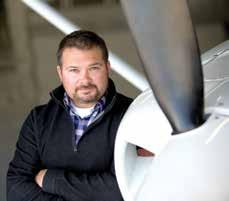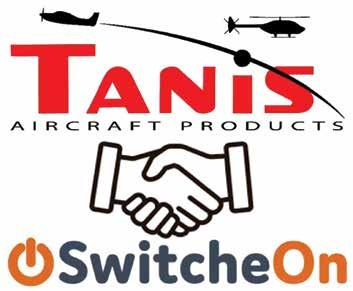
8 minute read
by Kyle Lewis
Great Lakes Regional Report Compatible Land Use – Grant Obligations
by Kyle Lewis
Advertisement
Regional Manager Airports & State Advocacy, Great Lakes Region Aircraft Owners & Pilots Association www.aopa.org
In a recent article, I covered a few topics found in the “grant assurances,” and one of those deserves more attention. Compatible Land Use – Grant Obligation #21. The assurance states: “It [the airport sponsor] will take appropriate action, to the extent reasonable, including the adoption of zoning laws, to restrict the use of land adjacent to or in the immediate vicinity of the airport to activities and purposes compatible with normal airport operations, including landing and takeoff of aircraft. In addition, if the project is for noise compatibility program implementation, it will not cause or permit any change in land use, within its jurisdiction, that will reduce its compatibility, with Airport Sponsor Assurances 2/2020 Page 10 of 18 respect to the airport, of the noise compatibility program measures upon which Federal funds have been expended.”
That seems simple enough, right? There are a couple of things going on here. First, the FAA is expecting local authorities to maintain adequate zoning around airports to protect the airport operations and reduce the possibility of noise complaints by restricting the use of land. Second, if an airport has a noise compatibility program (usually for commercial service airports), then the land use outlined in that program must be AOPA Great LakesHeading 2017.indd 1adhered to.
For discussion, let’s focus on the first issue – land use and zoning. The FAA has made it clear that high density residential, schools, churches, and certain other developments that would attract wildlife are not considered compatible land uses near airports. Noise and safety (for both aircraft and persons on the ground) are driving factors.

A Strategic Partnership To Provide The Most Advanced Cellular Option To Activate Power Remotely For Tanis Engine & Avionics/Cabin Preheat Systems
SwitcheOn Celluar Remote Tanis Engine Preheat Systems • Piston • Turbine • Rotorwing
Avionics/ Cabin Preheater
Wisconsin Aviation Trades Association
PROUD SPONSORS HELPING TO MOVE WISCONSIN BY AIR!
Gold Midwest Flyer Magazine 608-772-1776 www.midwestflyer.com Oregon, Wis.
Silver Beaver Aviation 920-386-2636 Juneau, Wis.
Horizon Aircraft Engine Services, Inc. - d/b/a Bolduc Aviation 763-780-1185 www.bolducaviation.com Minneapolis, Minn.
Bronze Fond du Lac Skyport 920-922-6000 www.fdlskyport.com Fond du Lac, Wis.
Jet Air Group 866-676-7835 www.jetairgroup.com Green Bay, Wis.
NewView Technologies 877-303-0709 www.newviewtech.com Oshkosh, Wis.
Racine Commercial Airport 262-631-5620 Racine, Wis.
Trimcraft Aviation 800-558-9405 www.TrimcraftAviation.com Genoa City, Wis.
West Bend Air, Inc. 800.310.5603 www.wbair.net West Bend, Wis.
Wisconsin Aviation, Inc. 800-657-0761 www.wisconsinaviation.com Juneau • Madison • Watertown, Wis.
For Membership Application Call 920-303-0709 wataonline.org
The FAA Southern Region instituted a “Land Use Compatibility Planning Task Force” in 1998. The mission was to create policy to better integrate airport master planning into local community planning processes. The task force developed a resource guide for local jurisdictions identifying airport overlay zones and navigation easements. By educating and raising awareness about land use near airports, the FAA believes it will slow the development of incompatible land uses. This document can be found at https://www.faa.gov/about/WATA Difference Is office_org/headquarters_offices/apl/noise_emissions/planning_toolkit/media/III.B.pdf It is important to remember that the FAA will not approve or disapprove specific Sponsored By These Members & Affiliates: developments near an airport. The Obstruction Evaluation (OE) process is designed to identify hazards to air navigation, allow public comment, and provide information to the local government to make an informed decision whether to approve or deny any zoning or construction permits. Many states and local jurisdictions dictate zoning and permitting processes for tall structures in areas that fall under 14 CFR Part 77.9. These areas are specific to any structure 200 feet or more above ground level (AGL), could emit frequencies, or are in the Part 77 instrument approach area and may exceed the prescribed slope ratios. This process is very technical and has an FAA office dedicated to OE studies. For further information, this is the official FAA website: https://oeaaa.faa.gov/oeaaa/external/portal.jsp
AOPA’s airport advocacy work is diverse. In fact, nationwide AOPA is involved in 22 compatible land use problems, 21 obstruction/hazard cases, and 7 large-scale noise impact issues. The issue of compatible land use is one of the biggest quandaries an airport can face. When developments pop up near an airport, noise complaints are not far behind, or calls of “unsafe airplanes” overhead. The political pressure can mount, airport development becomes stifled, and the possibility of closure becomes a reality. The most vulnerable airports are local community airports that may not be staffed full time, have limited resources, and no zoning control near the airfield. It is crucial for airports to be good neighbors, involve the community and civic leaders in airport events, and have a watchful eye on any proposed developments or zoning changes. Catching an issue early is key.
One of AOPA’s greatest assets in our airport advocacy work is the Airport Support Network (ASN) Program. Our ASN Volunteers are highly engaged at their local airport, maintain positive relationships with airport administration, and have direct access to AOPA’s airport advocacy team for topical resources. In the Great Lakes Region, nearly 400 volunteers are helping protect airports. If you are interested in this work, visit www.aopa.org/asn.
Regional Legislative Roundup
Indiana – Indiana House Bill 1001 relates to the state budget, and a noteworthy piece of the Bill calls for 100 percent of revenues from the excise tax collected on aviation fuel sales to be deposited into the dedicated aviation fund for direct airport grants. Currently, only 50 percent of that specific excise tax is diverted to the aviation fund. This will be a welcomed change that is supported by AOPA and Aviation Indiana (AI), the statewide
Minnesota Seaplane Pilots Association Safety Seminar September 17-19, 2021 Madden’s on Gull Lake - Brainerd, Minnesota
Seminars of Interest To All Pilots! Both Seaplanes & Aircraft On Wheels Welcomed! Land On Gull Lake or At East Gull Lake Airport (9Y2)
Brad Thornberg Photo
For hotel reservations and to register call Madden’s: 800-642-5363
association representing aviation interests. This change has been advocated by AI in previous budget cycles, and this time around has support from the Governor’s Office. At the time of writing, IN HB 1001 has been introduced and is awaiting the Ways and Means Committee.
Ohio – Ohio is also in a budget cycle for 2022-2023, and a recently released budget proposal from Governor DeWine’s Office details aviation funding at $6.4 million in each year of the biennium. Ohio House Bill 74 was introduced in February and state law provides that a budget be passed by June 30th to begin on July 1 of 2021. Updated language to the Ohio Airport Protection Act is also part of the overall bill, specific to the processes of tall structure permitting administered by the Ohio Department of Transportation, Office of Aviation.
AOPA is monitoring other bills, two in South Dakota: one that enhances privacy laws by restricting certain uses of drones (SD SB 74). SB 74 is awaiting signature by Governor Noem. Another bill, SB 157, introduced by South Dakota State Senator David Johnson, aims to earmark $3 million to the Rapid City Airport for “base infrastructure improvements.” The bill details that the monies can be used to install, replace, or repair necessary infrastructure improvements. The legislation has passed the Senate Transportation Committee with a 5-1 vote on February 3, 2021.
As the season progresses, AOPA will be watching for other specific aviation legislation and respond appropriately! (kyle.lewis@aopa.org) q
ASk Pete continued From PAge 14
Q: My flight instructor told me if I was an old geezer like him, the requirements for a signoff for tailwheel, highperformance, and complex gear operations might not be needed if I flew those airplanes before a certain date. Is that true? After you answer that, I have more questions to follow.
A: A tailwheel endorsement is not needed if a person has logged PIC (Pilot In Command) time in a tailwheel airplane before April of 1991. A high-performance, or complex gear endorsement, is not needed if a pilot has logged time in those airplanes as PIC before August 1997.
Follow up questions:
Q #1: What is the difference between high-performance airplane and a complex airplane?
A: High-performance airplanes are defined as airplanes that have MORE than 200 hp. Complex airplanes have retractable gear, flaps, and a constant speed prop. An example of a high-performance airplane would be the Cherokee 235 Pathfinder (235 hp, but fixed landing gear.) An example of a complex airplane could be a Piper Arrow of any year.
Continued on Page 60
Minnesota Aviation Trades Association – Investing In The Future!
Congratulations to NATHAN WURST of Chaska, Minnesota, who was selected to receive the 2019 MATA Scholarship!
Nathan is working on his private pilot certificate at Thunderbird Aviation at Flying Cloud Airport in Eden Prairie, Minnesota, and has been accepted at the University of North Dakota John D. Odegard School of Aerospace Sciences beginning this fall. To help pay for his education, Nathan started working as a line service technician at Thunderbird Aviation in the fall of 2018 while a senior in high school. Nathan stated: “I believe
in hard work and focus in order to succeed as a pilot. I see the aviation community as bonded over its love of flight… It is a community that I am proud to be a part of for the rest of my life.”
To be eligible for the MATA Scholarship, applicants must be currently enrolled in a flight training curriculum at a Minnesota flight school that is also a member of MATA, and write an essay on why they want to learn to fly or continue their training. The applicant’s ability to communicate their current position and future goals is very important. The scholarship application, details, updates and requirements can be found at https://www.mata-online.org/ One of the goals of the Minnesota Aviation Trades Association is to help create tomorrow’s aviation professionals, while supporting member flight schools. Aviation businesses interested in becoming a MATA member and supporting the organization’s efforts to promote and represent the industry before government, should contact Nancy Olson at 952-851-0631 Ext 322 or email
ngo@thunderbirdaviation.com.











